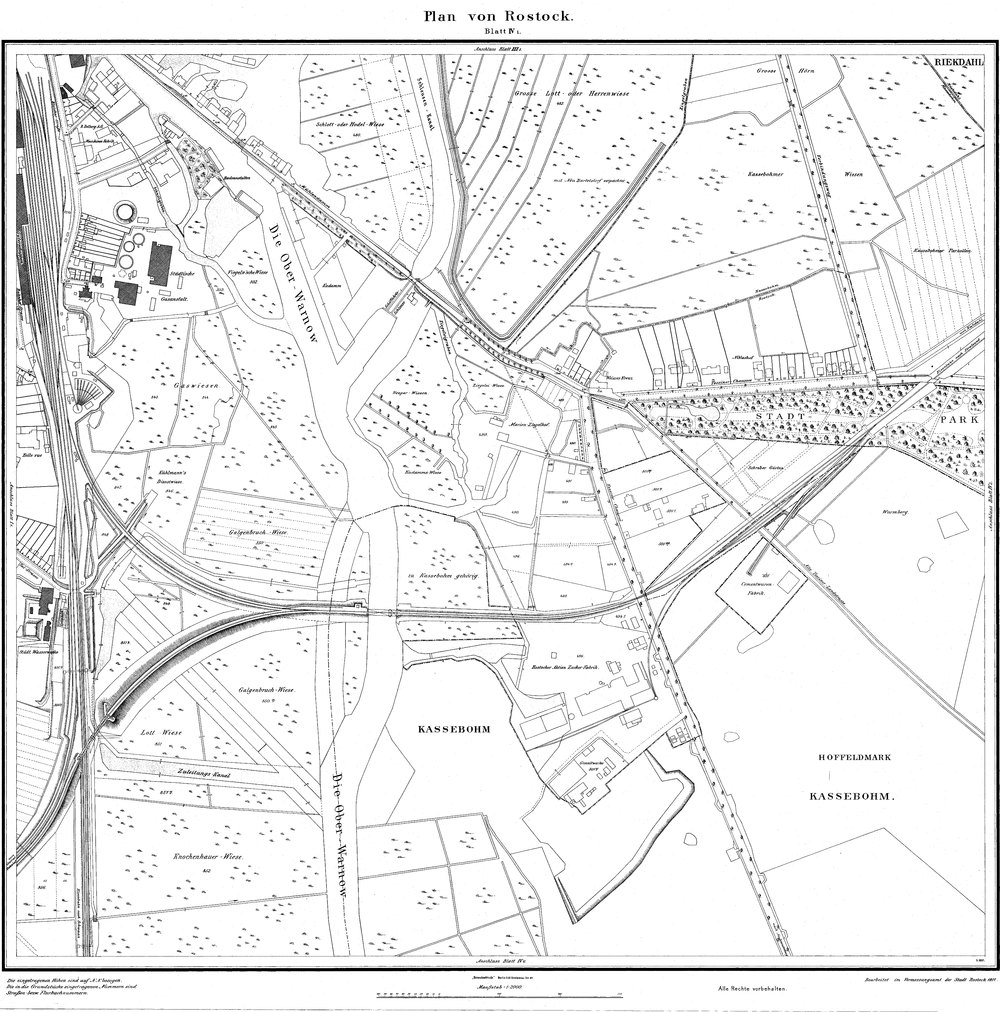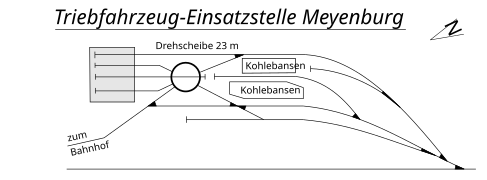Rostock railway depot
The depot Rostock (short Bw Rostock ), since 1994 as a depot Rostock (short Bh Rostock ) by train internal abbreviation WR 1 refers is of the DB Regio AG operated and the maintenance, repair and making available is of locomotives and railcars in Mecklenburg -Vorpommern are deployed or are stationed in Rostock .
history
The history of the Rostock depot began in 1850. This year the Mecklenburg Railway Company built a restoration facility with a locksmith's shop and storage space for the locomotives east of the Friedrich-Franz-Bahnhof on the Warnowwiesen. The four-track locomotive shed was initially preceded by a hand-operated 13.5-meter turntable. In the years that followed, the facilities were gradually expanded and the turntable enlarged to 16 meters in diameter.
In the course of the opening of the line between Wismar and Rostock in 1883, the Wismar-Rostocker Eisenbahn-Gesellschaft built a double-track rectangular shed for its locomotives southwest of the Friedrich-Franz train station with associated treatment systems. After the creation of the Grand Ducal Mecklenburg Friedrich-Franz Railway , these systems lost their importance and were completely demolished shortly afterwards for the expansion of the Friedrich-Franz railway station between 1892 and 1895.
Another depot was built with the construction of the Lloydbahn between Neustrelitz and Warnemünde in 1886. It was located southeast of the newly built Lloyd station and included a workshop with engine sheds and treatment facilities. After the creation of the Grand Ducal Mecklenburg Friedrich-Franz Railway, these systems were converted into a locomotive and wagon workshop. Later, the Rostock Reichsbahn repair shop developed from it .
In the course of the restructuring of the entire station facilities in Rostock at the end of the 19th century, the Lloyd station was transformed into a central passenger station and the Friedrich-Franz station into a freight station. The newly created passenger station was to receive a modern railway depot for the storage and treatment of the locomotives operating there and for this reason a 14-track roundhouse with a 19-meter turntable and the associated ancillary buildings and treatment facilities was built at the eastern end of the station on Herwegh-Straße built. However, it quickly became clear that the depot at this location could not be expanded and therefore the Deutsche Reichsbahn was looking for an alternative location. After a suitable site had been found between the tracks to Bützow and Laage, work on the new building began in 1926.
In 1929 the new depot started operations. It had a roundhouse with 15 tracks and a 23-meter turntable in front, a small locomotive and a railcar shed and three coal bans. The associated outbuildings were completed by 1933. At this point all other locations were given up. The former depot at the freight station became a wagon workshop for quick repairs, which was later closed. The listed buildings have been falling into disrepair ever since. Most of the former depot on Herwegh-Straße was demolished, and the remaining buildings are used by some craft businesses.
During the air raids on Rostock in 1944 and 1945, the depot suffered heavy hits. However, it was completely rebuilt after the Second World War by the early 1950s.
It was thanks to the closure of several railway depots in the Rostock area that the Rostock depot gained in importance after reunification. When Deutsche Bahn AG was founded in 1994, the depot was converted into a depot, which was then assigned to DB Regio AG on January 1, 1999. After modernization until August 2003, the depot has since been used for the maintenance of locomotives and railcars that are used by DB Regio AG in Mecklenburg-Western Pomerania.
Locomotive inventory
The following locomotive inventory can be verified for 1919:
- Prussian P 3.1 , later class 34 73 : 7 pieces
- Prussian P 4.2 , later class 36 6 : 6 pieces
- Prussian G 5.1 , later series 54 0 : 4 pieces
- Prussian T 1 : 4 pieces
- Mecklenburg T 3 , later class 89 80 : 8 pieces
- Mecklenburg T 4 , later series 91 19 : 2 pieces
- Mecklenburg T 7 , later class 99 30 : 3 pieces
By 1932 the number of locomotives had changed almost completely. This year Rostock was home to the following 37 locomotive series:
- Series 17 10–12 : 2 pieces
- Series 38 10–40 : 2 pieces
- Series 55 16–22 : 2 pieces
- Series 55 58 : 2 pieces
- Series 56 2–8 : 2 pieces
- Series 75 10–11 : 12 pieces
- Series 89 80 : 3 pieces
- Series 91 19 : 8 pieces
- Series 99 30 : 2 pieces
- Series 99 31 : 2 pieces
After the Second World War, the number of locomotives had almost doubled. In 1946 a total of 66 locomotives were stationed in Rostock:
- Series 03 1 piece
- Series 17 10–12 4 pieces
- Series 36 6 2 pieces
- Series 38 10–40 128 pieces
- Series 50 35 3 pieces
- Series 52 9 pieces
- Series 55 16–22 2 pieces
- Series 55 58 9 pieces
- Series 56 20–29 3 pieces
- Series 57 10–35 1 piece
- Series 75 10–11 6 pieces
- Series 86 1 piece
- Series 91 19 2 pieces
- Series 99 31 2 pieces
- Series 99 32 3 pieces
As early as 1951, the V 36 was the first diesel locomotive to join the fleet. The series V 60 10 followed in 1962 and the two series V 100 and V 180 in 1967 . When the class 132 was introduced in the mid-1970s, the last steam locomotives in Rostock were finally decommissioned, so that the depot was steam-free in May 1978. As a result of the energy crisis, there was another brief steam locomotive operation between 1982 and 1985 with the class 50 35 . A short time later, the first electric locomotives, the 243 series, were stationed in Rostock.
In summer 2006, locomotives of the class 143 and railcars of the classes 628 and 642 were based in Rostock. Rail buses of the 771/772 series were also part of the inventory.
Job sites
Before 1945, the Rostock depot was assigned the Warnemünde, Bützow and Arendsee locomotive stations (from 1938 Kühlungsborn West) as well as the Tribsees locomotive station and the locomotive sheds and restoration facilities in Neubukow, Bad Doberan, Schwaan, Ticino, Laage and Ribnitz.
After the Second World War, the locations in Bad Doberan, Kühlungsborn West, Neubukow and Warnemünde (all four since 1945), as well as Graal-Müritz (since 1950) and Güstrow, Meyenburg, Teterow (all three since 1993) belonged to the Rostock depot. Bad Doberan, Graal-Müritz and Neubukow were later closed. After the transformation of the depot on January 1, 1994, the remaining deployment locations remained at the Rostock depot.
See also
literature
- Lothar Schultz: The time of the steam locomotives in Mecklenburg . Ostseedruck Rostock, 1988, pages 16-21.
- Klaus-Jürgen Kühne: Railway depots in the GDR . transpress Verlag, page 2017, ISBN 978-3-613-71549-3 , page 135-136.
Coordinates: 54 ° 4 ′ 17.1 ″ N , 12 ° 8 ′ 33.6 ″ E









